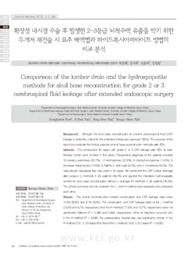

PARTNER
검증된 파트너 제휴사 자료
확장성 내시경 수술 후 발생한 2-3등급 뇌척수액 유출을 막기 위한 두개저 재건술 시 요추 배액법과 하이드록시아파타이트 방법의 비교 분석 (Comparison of the lumbar drain and the hydroxyapatite methods for skull base reconstruction for grade 2 or 3 cerebrospinal fluid leakage after extended endoscopic surgery)
8 페이지
최초등록일 2025.04.01
최종저작일
2020.05

-
미리보기
서지정보
· 발행기관 : 대한두개저학회
· 수록지 정보 : 대한두개저학회지 / 15권 / 1호 / 14 ~ 21페이지
· 저자명 : 박상혁, 김지희, 김용휘, 김영훈
초록
Background : Although the skull base reconstruction to prevent cerebrospinal fluid (CSF) leakage is extremely critical for the extended endoscopic approach (EEA), The purpose of this report is to evaluate the clinical outcome of skull base reconstruction methods after EEA.
Methods : The consecutive 62 cases with grade 2 or 3 CSF leakage after EEA at Asan Medical Center were enrolled in this study. Preoperative diagnosis of the patients included 19 pituitary adenomas (30.7%), 14 meningiomas (22.6%), 9 craniopharyngiomas (14.5%), 9 sinonasal malignancies (14.5%), 6 Rathke’s cleft cysts (9.7%), and 4 chordomas (6.5%). The vascularized nasoseptal flap was used in all cases. We performed the CSF lumbar drainage after surgery (L-method) in 30 patients (48.4%) and applied the injectable hydroxyapatite cement for skull base reconstruction without L-drainage (H-method) in 28 patients (45.2%).
The clinical outcomes and risk between the L- and H-method were assessed and compared each other.
Results : The overall reconstruction-related complication and CSF leakage rates were 12.9% (8/62) and 8.1% (5/62). The complication and CSF leakage rates of the L-method (10.0% and 6.7%, respectively) and the H-method (17.9.% and 10.7%, respectively) were not significantly different (P = 0.386 and 0.583, respectively). While all infections occurred only in the H-method (P = 0.066), the postoperative hospital stay was significantly shorter in the H-method (7.9 ± 2.9 days) than that of the L-method (10.8 ± 6.2 days) (P = 0.035).
Conclusions : The skull base reconstruction method using the hydroxyapatite effectively prevented the CSF leakage and provided comfort and shorter hospitalization to patients without postoperative lumbar drainage. When using the hydroxyapatite, however, the postoperative infection should be considered.영어초록
Background : Although the skull base reconstruction to prevent cerebrospinal fluid (CSF) leakage is extremely critical for the extended endoscopic approach (EEA), The purpose of this report is to evaluate the clinical outcome of skull base reconstruction methods after EEA.
Methods : The consecutive 62 cases with grade 2 or 3 CSF leakage after EEA at Asan Medical Center were enrolled in this study. Preoperative diagnosis of the patients included 19 pituitary adenomas (30.7%), 14 meningiomas (22.6%), 9 craniopharyngiomas (14.5%), 9 sinonasal malignancies (14.5%), 6 Rathke’s cleft cysts (9.7%), and 4 chordomas (6.5%). The vascularized nasoseptal flap was used in all cases. We performed the CSF lumbar drainage after surgery (L-method) in 30 patients (48.4%) and applied the injectable hydroxyapatite cement for skull base reconstruction without L-drainage (H-method) in 28 patients (45.2%).
The clinical outcomes and risk between the L- and H-method were assessed and compared each other.
Results : The overall reconstruction-related complication and CSF leakage rates were 12.9% (8/62) and 8.1% (5/62). The complication and CSF leakage rates of the L-method (10.0% and 6.7%, respectively) and the H-method (17.9.% and 10.7%, respectively) were not significantly different (P = 0.386 and 0.583, respectively). While all infections occurred only in the H-method (P = 0.066), the postoperative hospital stay was significantly shorter in the H-method (7.9 ± 2.9 days) than that of the L-method (10.8 ± 6.2 days) (P = 0.035).
Conclusions : The skull base reconstruction method using the hydroxyapatite effectively prevented the CSF leakage and provided comfort and shorter hospitalization to patients without postoperative lumbar drainage. When using the hydroxyapatite, however, the postoperative infection should be considered.참고자료
· 없음태그
-
자주묻는질문의 답변을 확인해 주세요

꼭 알아주세요
-
자료의 정보 및 내용의 진실성에 대하여 해피캠퍼스는 보증하지 않으며, 해당 정보 및 게시물 저작권과 기타 법적 책임은 자료 등록자에게 있습니다.
자료 및 게시물 내용의 불법적 이용, 무단 전재∙배포는 금지되어 있습니다.
저작권침해, 명예훼손 등 분쟁 요소 발견 시 고객센터의 저작권침해 신고센터를 이용해 주시기 바랍니다. -
해피캠퍼스는 구매자와 판매자 모두가 만족하는 서비스가 되도록 노력하고 있으며, 아래의 4가지 자료환불 조건을 꼭 확인해주시기 바랍니다.
파일오류 중복자료 저작권 없음 설명과 실제 내용 불일치 파일의 다운로드가 제대로 되지 않거나 파일형식에 맞는 프로그램으로 정상 작동하지 않는 경우 다른 자료와 70% 이상 내용이 일치하는 경우 (중복임을 확인할 수 있는 근거 필요함) 인터넷의 다른 사이트, 연구기관, 학교, 서적 등의 자료를 도용한 경우 자료의 설명과 실제 자료의 내용이 일치하지 않는 경우
“대한두개저학회지”의 다른 논문도 확인해 보세요!
-
전정신경초종과 청력손상 5 페이지
Vestibular schwannomas (VSs) are the most common tumors of the cerebellopontine angle. Although VSs arise from the vestibular nerves, 95% of patients with VS present with sensorineural hearing loss (S.. -
외이도 편평세포암종 1예 6 페이지
Squamous cell carcinoma (SCC) of the external auditory canal is uncommon malignancy with an annual incidence of one per one million inhabitants. Common tumor progression site are periauricular soft ti.. -
거대 추체부 경동맥류에 의해 유발된 일측성 재발성 삼출성 중이염: 증례보고 및 문헌 검토 5 페이지
We present a case of unilateral recurrent otitis media with effusion and eustachian tube dysfunction caused by a giant aneurysm arising from the petrous segment of the internal carotid artery (ICA). P.. -
귀수술에서 드릴의 소음이 비수술측 귀에 미치는 영향 6 페이지
Background : Many studies have suggested that mastoidectomy possibly induces hearing loss in the contralateral non-operated ear through excessive noise or vibration energy from drilling. The aim of th.. -
부비동염에서 기원한 진균성 동맥류의 치료과정 중 발생한 코일의 이동 5 페이지
Invasive sphenoid fungal sinusitis sometimes invades the adjacent structures such as the optic nerve or cavernous sinus. Here, we present the treatment for a primarily embolized mycotic aneurysm that ..
문서 초안을 생성해주는 EasyAI
